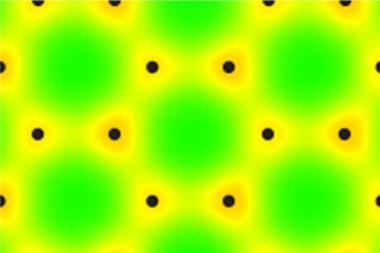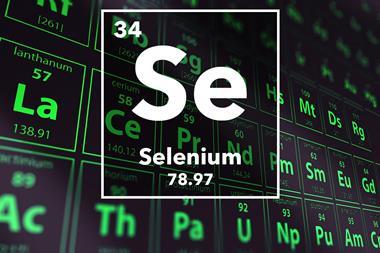Researchers in China have reported new evidence that they believe finally resolves a long-standing debate over the structure of amorphous selenium. Their structural analysis suggests that vapour-deposited samples form eight-membered rings rather than chains of atoms, but other researchers remain unconvinced by these latest results.
Selenium, belonging to the chalcogen family, was first discovered over 200 years ago. Its crystal allotropes are well-characterised but the amorphous form is more controversial, with evidence of both ring and chain structures under different conditions. Sulfur and tellurium, which sit above and below selenium in the periodic table, adopt monomer S8 rings and polymeric Ten chains respectively. But distinguishing between these structures is challenging for selenium using traditional techniques.
The Chinese team, led by inorganic chemist Ding-Jiang Xue from the Beijing National Laboratory for Molecular Sciences, notes that the structural parameters of selenium chains and rings – like bond length and bond angles – are so similar that it is difficult to tell them apart. The researchers write that the structure of amorphous selenium also depends on methods used to prepare it, for example melt-quenching or vapour deposition. Previous work by US-based researchers Sabyasachi Sen and Kirill Kovnir identified that chains predominate in melt-quenched selenium samples, but the structure of vapour-deposited selenium – a crucial component of x-ray detectors – remained ambiguous.
Xue’s team used a combination of analytical techniques to probe the molecular structure of vapour-deposited samples. The researchers then compared these results with the characteristic spectroscopic peaks of crystalline selenium allotropes – monoclinic selenium with ordered Se8 rings, and trigonal selenium with ordered polymeric Sen chains – and found that the vapour-deposited spectra were almost identical to those of the monoclinic samples.

With evidence pointing towards the ring structure, the team sought to determine the origin of the earlier confusion, using density functional theory to investigate the formation of ring versus chain structures. These calculations revealed that rings have a lower formation energy but easily transition to the more stable chain structure in the presence of heat or light. The researchers note that this means that certain characterisation techniques such as Raman spectroscopy could ‘inadvertently trigger the ring to chain transition during the measurement process’.
To test this hypothesis, the Chinese team probed vapour-deposited samples under a variety of Raman conditions, including at reduced power densities and temperatures. The characteristic chain peak at 251cm-1 dominated in most experiments but, as the team lowered the power density and temperature, this signal was replaced by a 254cm-1 peak, indicative of a ring structure.
However, while Xue and his colleagues believe that this is conclusive evidence for the ring form, with the facile transition to the chain structure to blame for the controversy, Sen is less convinced.
‘The experiments are carefully conducted; results are solid but in my opinion are inconclusive,’ he says. ‘I would say the shift they observe at -40°C is due to thermal contraction of the bonds in the material.’
‘Also, distinguishing between 251cm-1 and 254cm-1 for such broad bands at the signal level at low power or low temperature is not easy and I worry about repeatability of these measurements,’ he adds.
References
W Lu et al, J. Am. Chem. Soc., 2024, DOI: 10.1021/jacs.4c00219

















No comments yet